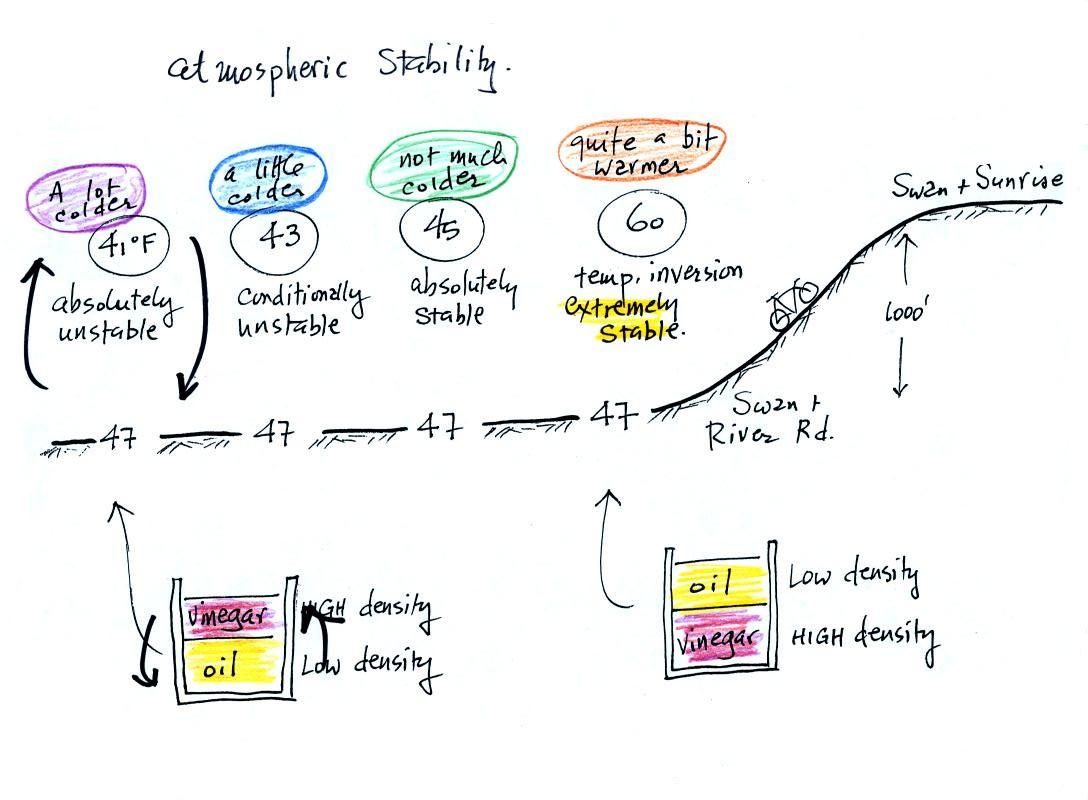Click here to download this
supplementary reading section in a easier to print format
This is an
example of a habit I have of "beating some concepts to
death." The rather
busy picture below illustrates how small changes in how
air temperature changes with increasing altitude can determine whether
the atmosphere will be stable or unstable. Just for
the
purposes of illustration imagine riding a bicycle north from Swan and
River Rd up the hill to Swan and Sunrise (fhe figure shows an elevation
change of 1000 ft, it is actually quite a bit less than that).

At far left the air temperature goes from 47o F to 41o
F, a drop of 6o
F. This is a
fairly
rapid rate of decrease with increasing altitude and would make the
atmosphere
absolutely unstable.
The
atmosphere
wouldn't
remain
this
way.
Air
at
the
ground
would
rise, air higher up would sink, and
the
temperature profile would change (the rate of decrease with increasing
altitude would lessen). In some ways it would be like
trying to pour vinegar on top of oil in a glass. The lower
density oil would rise because it would "want" to float on top of the
higher density vinegar.
The next picture shows air temperature decreasing a little more slowly
with increasing altitude. This small change makes the atmosphere
conditionally unstable
(we won't go into what the conditions might
be). The
atmosphere is often in this state.
The atmosphere cools only 2o F in
1000 feet in the next
picture.
This creates
an absolutely stable
atmosphere. Air at the ground will remain at
the ground and won't rise and mix with air higher up. Compare
this with the glass containing vinegar and a layer of oil on top.
The two layers won't mix.
Air temperature in the last figure actually increases with increasing
altitude. This is a temperature
inversion and is very common on
winter mornings. The atmosphere is extremely stable under
these conditions.
Temperature inversions are something you can check out for
yourself. Head north on Swan
Rd. on your bicycle early some winter morning. You will pass
through
some pretty cold air as
you cross the Rillito River. By the time you get to Sunrise, the
air can be 10 to 15 degrees warmer and will seem balmy compared to the
cold
air at the bottom of the hill. If you're up for a real
hill-climbing challenge
continue north on Swan past Skyline. You'll find a short but very
steep section of road at the far north end of Swan.
And as long as we're talking about bicycle riding. I was in
France in July 2009 trying to ride my bike up
some
of the famous Tour de France mountain stages in the Alps. One of
the most famous is the Alpe d'Huez. That's my bicycle below, a
green
"Gilmour" (Andy Gilmour is a local bicycle builder) at the top of the
Alpe d'Huez.
I was back in France, in the Pyrrennees in 2010. The next
picture
shows the last 3 or 4 km of the road to the
summit of Mt. Ventoux, another famous Tour de France climb.

